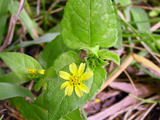Native Plants

Q. Who is Mr. Smarty Plants?
A: There are those who suspect Wildflower Center volunteers are the culpable and capable culprits. Yet, others think staff members play some, albeit small, role. You can torture us with your plant questions, but we will never reveal the Green Guru's secret identity.
Did you know you can access the Native Plant Information Network with your web-enabled smartphone?
Ask Mr. Smarty Plants is a free service provided by the staff and volunteers at the Lady Bird Johnson Wildflower Center.

rate this answer
Sunday - August 02, 2015
From: New Braunfels, TX
Region: Southwest
Topic: Seed and Plant Sources, Planting, Groundcovers, Shade Tolerant, Herbs/Forbs
Title: Where to find Horseherb seed
Answered by: Guy Thompson
QUESTION:
I would like to purchase some Horseherb seeds. Can you tell me where I can do that? Either locally or on line. Thank you.ANSWER:
Calyptocarpus vialis (Straggler daisy), also called Horseherb, seems to be native in your area. It is usually considered to be a weed, but many people appreciate its properties. It is great as a groundcover in shady areas. I recently saw a nice solid "lawn" of it by the cell phone lot at the Austin-Bergstrom airport. You may be able to find Straggler daisy in the wilds by looking in shady areas. I will attach several photos to guide you. Perhaps one of your local nurseries carries it. I have seen it in a vegetative state in nurseries but not as seed. The following suggestion for planting Straggler daisy is lifted from a web site I found.
"HOW TO EASILY “SEED” AN AREA: Simply find a fast growing, blooming stand of Horseherb and mow it periodically using a lawnmower with a grass catcher attachment. Then thinly spread the Horseherb catchings (clippings) onto the area to be planted. Let the clippings dry for a few days then water or let the next rainfall germinate the very small seed which were collected during mowing. Horseherb will establish itself in stony, shady areas where grass will not grow well. NOTE: Horseherb DOES NOT kill or crowd out grasses; the grass thins or dies and the Horseherb covers the bare spots!"
FROM THE IMAGE GALLERY
More Groundcovers Questions
Groundcover for steep hill in Georgia
May 04, 2009 - We have a large steep hill with only clay and rocks on it in the North Georgia Mountain area. What is a good Native ground covering to put on this for erosion? Something that grows fast preferably. ...
view the full question and answer
Growing mosses in the Pacific Northwest
February 05, 2015 - Can you provide information on types of Mosses as well as Microferns in the Northwest Mountain region near Seattle?
I assume that Mosses and Microferns are more resilient to foot traffic (i.e.Cush...
view the full question and answer
Groundcover or grass for Panama City, Florida
April 19, 2009 - Dear Mr. Smarty Plants
I live in Panama City Florida and am having great difficulty growing a lawn. I would prefer no lawn as grass, it seems a pointless use of resources but my husband requires gr...
view the full question and answer
Ground cover for a dry slope in PA
May 23, 2013 - My side yard is a slope with rocky (a lot of small serpentine rocks) soil under white and black pine trees. I can grow lots of weeds :-) but would like to plant a low (0-3in) evergreen ground cover th...
view the full question and answer
Plantings for a slope from New Carrollton MD
June 27, 2012 - My house (Maryland, near DC) sits at the bottom of a south facing slope. The soil is very heavy clay. The grade is about 1:20 for about 100 feet (with a steeper part at the top). Part of the hill is i...
view the full question and answer
| Support the Wildflower Center by Donating Online or Becoming a Member today. |

